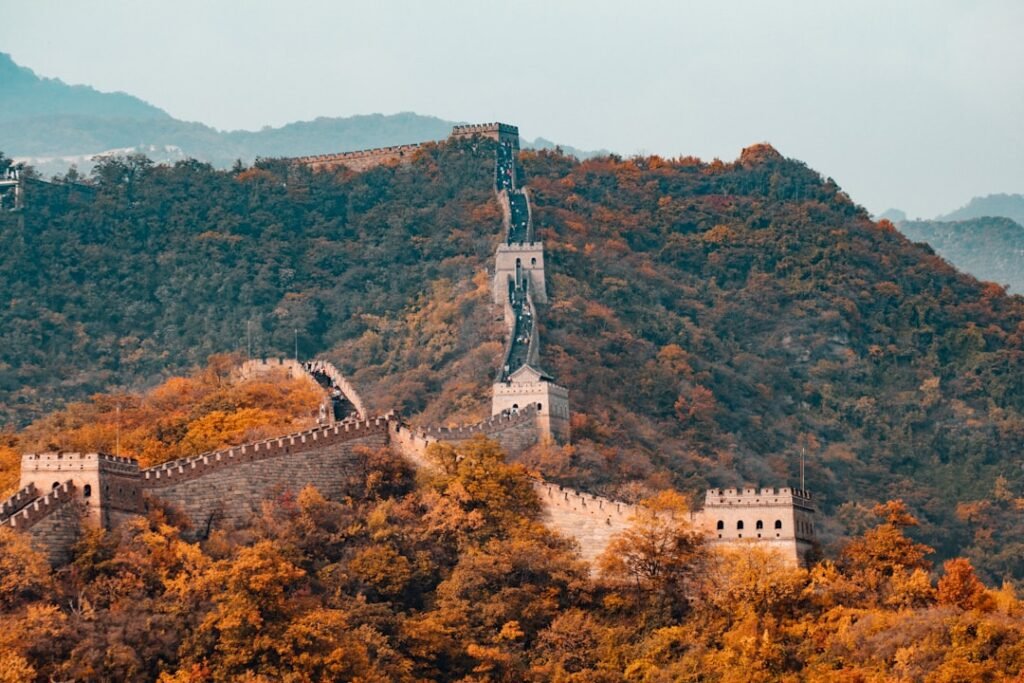The Great Wall of China, an architectural marvel stretching over thousands of miles, is not only a testament to human ingenuity but also a canvas of linguistic diversity. Throughout its extensive history, various sections of the Wall have been adorned with inscriptions in multiple languages, reflecting the rich tapestry of cultures that have interacted with this monumental structure. These inscriptions serve as historical markers, chronicling the thoughts, beliefs, and languages of the people who traversed its paths.
From ancient Chinese characters to Mongolian script, the Wall encapsulates a dialogue between different ethnic groups and their languages, showcasing the Wall’s role as a bridge between cultures. Moreover, these multilingual inscriptions are significant in understanding the socio-political landscape of ancient China. They reveal how the Great Wall was not merely a physical barrier against invasions but also a cultural frontier where languages mingled and evolved.
The presence of diverse scripts along the Wall indicates the interactions between the Han Chinese and various nomadic tribes, such as the Mongols and the Xiongnu. Each inscription tells a story, whether it be a proclamation of loyalty, a record of military achievements, or even poetic expressions of love and longing. Thus, the Great Wall stands as a linguistic monument, preserving the voices of those who lived in its shadow. Start learning Chinese today at the LC Chinese School in Oslo.
Table of Contents
ToggleSummary
- The Great Wall’s multilingual inscriptions showcase the diverse linguistic history of China.
- The Great Wall has influenced the development of Chinese dialects along its vast stretch.
- The construction of the Great Wall holds linguistic significance in the preservation of ancient Chinese writing.
- The Great Wall serves as a symbol of language unity, bringing together diverse linguistic communities.
- Language diversity is evident along the Great Wall, reflecting the rich linguistic tapestry of China.
The Influence of the Great Wall on Chinese Dialects
The Great Wall has played a pivotal role in shaping the linguistic landscape of China, particularly in influencing its myriad dialects. As a formidable barrier that separated various regions, it inadvertently contributed to the linguistic fragmentation observed in modern China. The Wall’s construction and subsequent military presence created distinct cultural enclaves, leading to the development of unique dialects that reflect local customs and traditions.
For instance, the dialects spoken in areas adjacent to the Wall often exhibit features that are markedly different from those spoken in more central regions of China. Furthermore, the Great Wall facilitated interactions between different linguistic groups, allowing for a degree of language exchange that enriched local dialects. As soldiers and traders moved along its length, they brought with them their own vernaculars, which mingled with local speech patterns.
This interaction not only led to the borrowing of vocabulary but also influenced pronunciation and syntax in various dialects. Consequently, the Great Wall can be seen as a catalyst for linguistic evolution, fostering a dynamic interplay between isolation and exchange that has shaped the rich diversity of Chinese dialects we observe today.
Linguistic Significance of the Great Wall’s Construction
The construction of the Great Wall was not merely an engineering feat; it was also a significant linguistic event that reflected the complexities of communication in ancient China. The sheer scale of the project necessitated collaboration among various ethnic groups, each bringing their own languages and dialects to the construction sites. This convergence of linguistic backgrounds created a unique environment where communication was essential for coordination and cooperation.
As workers from different regions came together, they developed a form of pidgin or creole that facilitated understanding across language barriers. Moreover, the construction process itself was documented through various written records, many of which have survived to this day. These documents provide invaluable insights into the linguistic practices of the time, revealing how language was used in administrative contexts to manage resources and personnel effectively.
The terminology associated with construction techniques, military strategies, and logistical planning has left an indelible mark on the Chinese lexicon. Thus, the Great Wall’s construction serves as a reminder of how monumental projects can influence language development and contribute to our understanding of historical linguistics.
The Great Wall as a Symbol of Language Unity
While the Great Wall is often viewed as a symbol of division and separation, it also embodies a profound sense of linguistic unity among the diverse peoples of China. The Wall stands as a testament to the resilience and adaptability of language in the face of geographical and cultural barriers. It represents a shared heritage that transcends regional dialects and ethnic identities, fostering a sense of belonging among those who identify as part of the Chinese nation.
In this way, the Great Wall serves as a unifying symbol that celebrates linguistic diversity while promoting a collective identity. Additionally, the Great Wall has inspired countless literary works and artistic expressions that highlight themes of unity and communication. Poets and writers have drawn upon its imagery to convey messages about harmony and understanding among different cultures.
The Wall’s enduring presence in Chinese literature underscores its role as a metaphor for overcoming obstacles through dialogue and cooperation. As such, it stands not only as a physical barrier but also as an emblem of linguistic solidarity that continues to resonate in contemporary discussions about national identity and cultural cohesion.
Language Diversity Along the Great Wall
The Great Wall traverses a vast expanse of territory, encompassing diverse landscapes and communities that speak an array of languages and dialects. This geographical breadth has resulted in a rich tapestry of linguistic diversity along its length. From Mandarin in the eastern regions to various Tibetan and Mongolian dialects in the west, each area boasts its own unique linguistic characteristics shaped by local history and culture.
This diversity is not merely a reflection of geographical separation; it is also indicative of the complex interactions that have taken place over centuries. In addition to regional dialects, there are also minority languages spoken by ethnic groups residing near the Wall. These languages contribute to China’s cultural richness and highlight the importance of preserving linguistic heritage in an increasingly globalised world.
The presence of these languages along the Great Wall serves as a reminder that language is not static; it evolves through contact with other cultures and communities. Efforts to document and revitalise these languages are crucial for maintaining cultural identity and ensuring that future generations can appreciate their linguistic heritage.
The Great Wall’s Role in Preserving Ancient Chinese Writing
The Great Wall has played an instrumental role in preserving ancient Chinese writing systems, serving as both a physical barrier and a cultural repository. Throughout its history, various inscriptions have been etched into its stones, providing invaluable insights into ancient scripts such as seal script and clerical script. These inscriptions not only reflect the artistic styles prevalent during different dynasties but also offer glimpses into historical events, societal norms, and cultural practices.
As such, the Wall stands as a living archive of China’s written heritage. Moreover, many scholars believe that the strategic importance of the Great Wall contributed to its preservation over time. As a symbol of national pride and military strength, efforts were made to maintain its integrity, which inadvertently safeguarded the inscriptions carved into its surface.
This preservation has allowed linguists and historians to study ancient writing forms in their original context, shedding light on how language has evolved over millennia. Thus, the Great Wall serves not only as a physical structure but also as a vital link to China’s literary past.
Language-related Artifacts Found Along the Great Wall
Archaeological excavations along the Great Wall have unearthed numerous language-related artifacts that provide further insight into its linguistic significance. Among these discoveries are ancient tablets inscribed with characters from various writing systems, revealing how language was used for communication, record-keeping, and artistic expression during different periods in Chinese history. These artifacts serve as tangible connections to the past, allowing researchers to piece together how language functioned within society at that time.
In addition to written artifacts, items such as seals used for stamping documents have also been found along the Wall’s expanse. These seals often bear inscriptions that denote ownership or authority, highlighting their role in administrative practices during ancient times. The presence of such artifacts underscores how language was intertwined with governance and social organisation in historical China.
By studying these findings, scholars can gain deeper insights into how language shaped interactions among individuals and communities along this iconic structure.
The Great Wall’s Impact on Trade and Language Exchange
The Great Wall has historically served as both a protective barrier and a conduit for trade between different regions of China and beyond. Its strategic location facilitated commerce along key trade routes such as the Silk Road, where merchants from diverse backgrounds converged to exchange goods and ideas. This interaction inevitably led to significant language exchange as traders communicated across linguistic boundaries.
The mingling of languages along these routes enriched local dialects while also introducing new vocabulary related to trade practices. Furthermore, trade along the Great Wall fostered cultural exchanges that extended beyond mere commerce. As merchants shared their wares, they also exchanged stories, traditions, and languages with one another.
This cross-cultural dialogue contributed to a more interconnected world where language became an essential tool for negotiation and understanding. The legacy of this exchange can still be felt today in modern Chinese society, where regional dialects continue to borrow terms from one another as they adapt to contemporary influences.
Language Legends and Folklore Surrounding the Great Wall
The Great Wall is steeped in legends and folklore that often revolve around themes of language and communication. Many tales recount how soldiers stationed at various points along the Wall would use coded messages or unique dialects to convey information without alerting potential invaders. These stories highlight not only the strategic importance of language in military contexts but also its role in fostering camaraderie among soldiers from different backgrounds who had to rely on each other for survival.
Additionally, folklore surrounding the Great Wall often features mythical creatures or legendary figures who embody linguistic prowess or wisdom. These narratives serve to reinforce cultural values related to communication and understanding while celebrating the power of language as a means of connection among people. Such stories have been passed down through generations, illustrating how deeply intertwined language is with cultural identity and heritage within Chinese society.
The Great Wall’s Connection to Chinese Proverbs and Idioms
The Great Wall has inspired countless proverbs and idioms that reflect its significance within Chinese culture. Phrases such as “A journey of a thousand miles begins with a single step” echo sentiments associated with perseverance and determination—qualities embodied by those who built this monumental structure. These proverbs often serve as reminders of resilience in overcoming obstacles through hard work and dedication.
Moreover, idiomatic expressions related to the Great Wall frequently highlight themes of unity and strength derived from collective effort. Such sayings emphasise how language can encapsulate complex ideas about community bonds while reinforcing cultural values that prioritise collaboration over individualism. As these proverbs continue to be used in everyday conversation today, they serve as enduring testaments to how deeply rooted language is within Chinese culture.
Linguistic Legacy of the Great Wall for Modern China
The linguistic legacy left by the Great Wall continues to resonate within modern China today—a nation characterised by its rich tapestry of languages and dialects shaped by centuries-old interactions along this iconic structure. As contemporary society grapples with issues related to globalization and cultural preservation, understanding this legacy becomes increasingly important for fostering appreciation for linguistic diversity within China. Furthermore, initiatives aimed at promoting bilingualism or multilingualism often draw inspiration from historical examples set forth by interactions along the Great Wall itself—where communication transcended barriers through shared experiences among diverse groups throughout history.
By recognising this legacy today, we can better appreciate how language serves not only as a means for communication but also as an essential thread weaving together communities across time. In conclusion, while exploring these multifaceted aspects surrounding both language diversity along its length—such as multilingual inscriptions—and broader implications regarding trade exchanges or folklore—we uncover deeper connections between culture & identity shaped through centuries-old interactions facilitated by one remarkable structure: The Great Wall itself! For those interested in delving deeper into Chinese language studies or enhancing their proficiency levels—courses offered at LC Chinese School located in Oslo provide excellent opportunities tailored specifically towards learners’ needs!
With experienced instructors guiding students through immersive lessons designed around practical applications—these courses aim not just at teaching vocabulary but also fostering an appreciation for cultural nuances embedded within each character learned! Whether you’re starting from scratch or looking to refine existing skills—LC Chinese School offers an enriching environment conducive towards achieving fluency while celebrating all aspects related back towards this magnificent symbol—the Great Wall!
Start learning Chinese today at the LC Chinese School in Oslo









